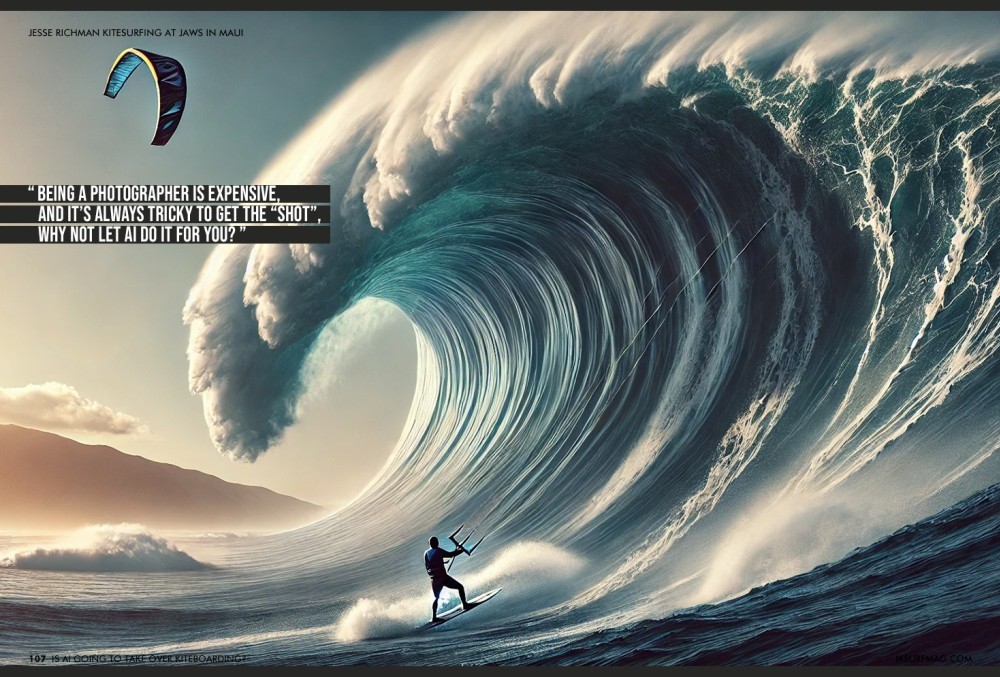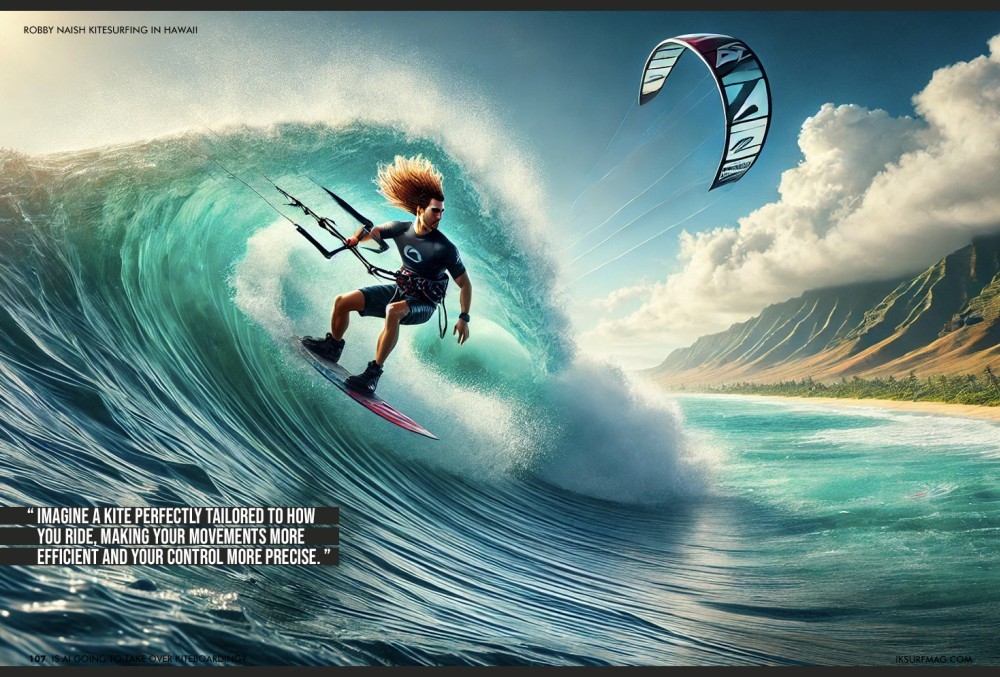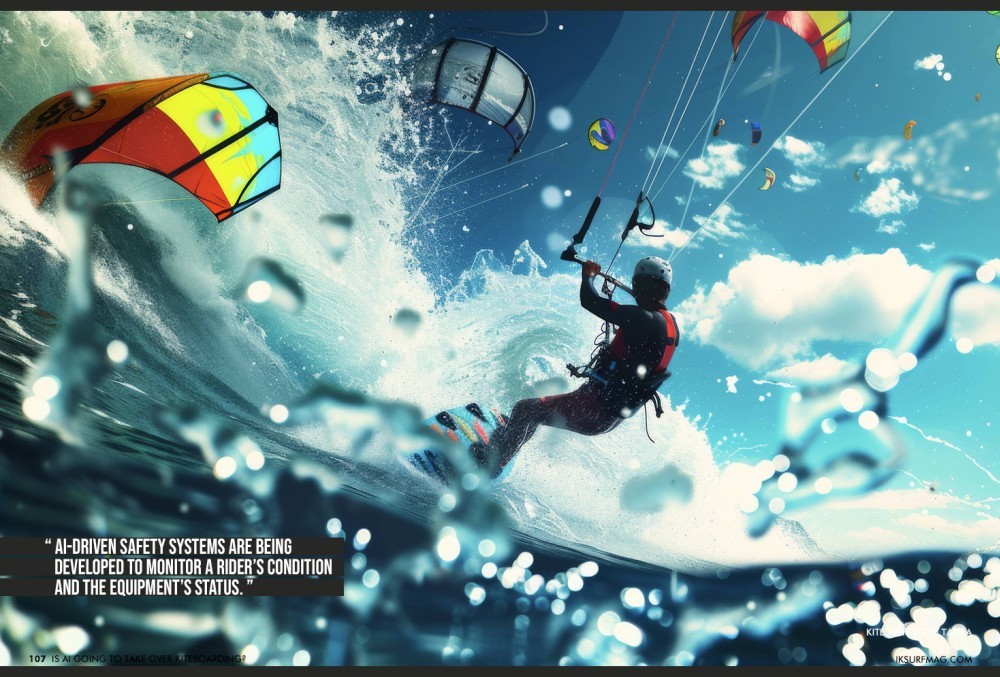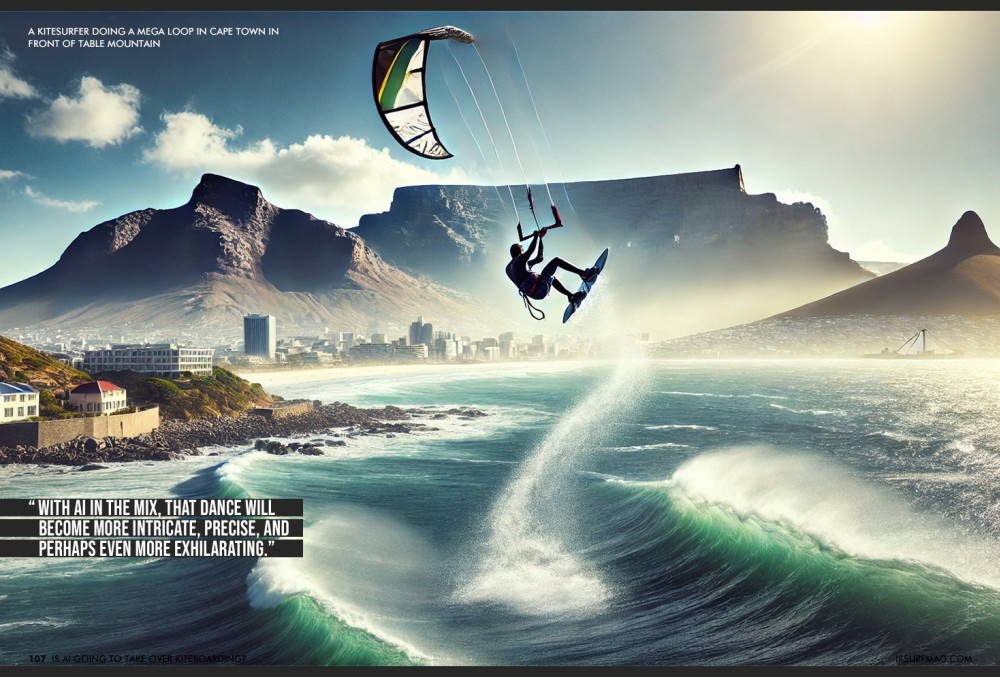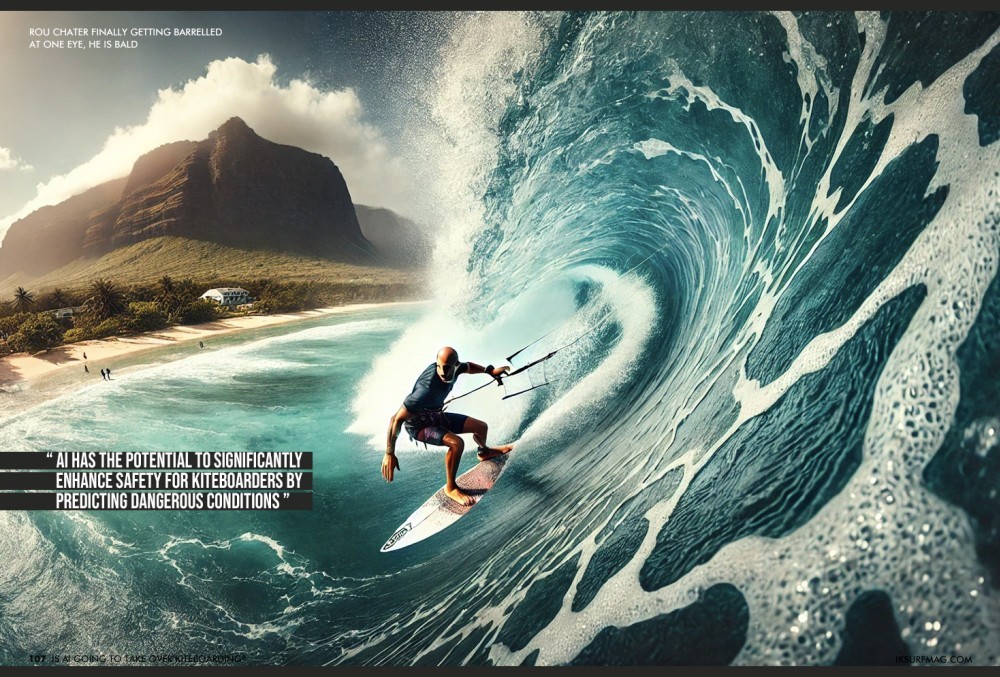
Is AI Going to Take Over Kiteboarding?
Issue 107 / Fri 11th Oct, 2024
With the increasing presence of AI in different aspects of kiteboarding, such as writing articles, taking photographs, and even riding. Rou Chater and AI discuss the potential impact of AI on the sport and whether it could eventually replace human professionals. Intrigued? Read on!
Forget the Olympics; that was last week's news… Unless you’ve been living under a rock lately, you’ll have been hearing a lot about AI. We’ve discussed it in the magazine, and given how the landscape is always changing within our sport, we thought it merited some further investigation.
Writing articles takes time, so why not let AI do it? Being a pro rider is hard work, so why not let AI do it for you? Being a photographer is expensive, and it’s always tricky to get the “shot”, why not let AI do it for you? This is just the beginning, who knows where this will end up. Look at social media; it used to be the case that pros were merited on their performance on the water; now it’s more about how many followers you have; could it be about how good the AI is in the future?
AI writers, photographers, and riders will be a lot cheaper than the real thing, so we asked AI to write this article and create all the images for us. While the pictures are funny, the text is a little scary, although we think AI-powered kites that fly us so we don’t have to bother might be a little far-fetched. Enjoy. Everything after this sentence was created by a machine that was asked the simple question: Is AI going to take over kiteboarding?
Riding the Winds of Change: Kiteboarding in the Age of AI
Kiteboarding, an exhilarating blend of surfing, paragliding, and wakeboarding, has long been a sport defined by the raw forces of nature and the skilled hands of its riders. As kitesurfers harness the power of the wind, skimming across the water’s surface or launching into the air for breathtaking aerial manoeuvres, they embody the spirit of freedom and adventure. Yet, in this world of wind and waves, a new force is making waves of its own: artificial intelligence (AI). The intersection of kiteboarding and AI is redefining the sport in ways that are as thrilling as they are transformative.
The Rise of AI in Kiteboarding
AI's encroachment into kiteboarding is not about replacing the rider but enhancing the experience. From safety training, AI is being integrated into various aspects of the sport, allowing kitesurfers to push their limits while minimising risks. For instance, AI-driven analytics platforms can now assess a rider’s performance in real-time, providing instant feedback on everything from body posture to the trajectory of their jumps. This is particularly beneficial for beginners, who can learn from the AI’s data-driven insights, as well as for seasoned professionals looking to refine their techniques.
Moreover, AI is revolutionising kite design. Traditional kites are crafted through a combination of experience, intuition, and trial and error. Now, AI algorithms can simulate countless design variations, optimizing kite shapes and materials for specific conditions. This leads to better performance and allows customisation to match individual riding styles and preferences. Imagine a kite perfectly tailored to how you ride, making your movements more efficient and your control more precise. That’s the power AI brings to the table.
Safety First: AI as a Guardian on the Water
Kiteboarding is an inherently risky sport. With the forces of nature at play, conditions can change rapidly, sometimes with dangerous consequences. AI is stepping in as a guardian, helping to mitigate these risks. Advanced weather prediction models powered by AI can now offer real-time updates on wind patterns, tidal shifts, and potential hazards, allowing riders to make informed decisions about when and where to ride.
In addition, AI-driven safety systems are being developed to monitor a rider’s condition and the equipment’s status. For example, sensors embedded in the kite or harness can detect anomalies like a sudden drop in wind or an unexpected equipment failure. The system can then alert the rider or even take automated actions, such as adjusting the kite’s position to avoid a crash. These innovations are making kiteboarding safer, allowing riders to focus more on the thrill of the ride and less on the potential dangers.
The Future: AI as a Co-Pilot
The role of AI in kiteboarding could expand even further, potentially transforming the sport into a collaborative effort between humans and machines. Imagine an AI-powered kite that learns from your movements, gradually adapting its responses to your style and preferences. Such a kite could act as a co-pilot, helping you execute complex manoeuvres with greater precision or compensating for environmental changes on the fly.
This symbiosis opens up new avenues for the sport. Competitive kiteboarding, for instance, could see the introduction of AI-assisted categories, where the rider’s skill is complemented by their ability to work with AI technology. This could lead to entirely new forms of competition, where creativity and innovation are as important as physical prowess.
A New Era of Kiteboarding
As AI continues to evolve, its integration into kiteboarding will likely deepen, bringing about changes that are both exciting and challenging. The sport will always retain its essence—a dance between rider, wind, and water—but with AI in the mix, that dance will become more intricate, precise, and perhaps even more exhilarating.
In this new era, kiteboarding will remain a sport for those who seek the thrill of the open water and the rush of the wind. But it will also become a playground for innovation, where technology and nature converge in ways that push the boundaries of what’s possible. Whether you’re a seasoned pro or a newcomer to the sport, the fusion of kiteboarding and AI promises a future where the sky is not the limit—it’s just the beginning.
Is AI Going to Take Over Kiteboarding?
Kiteboarding, also known as kitesurfing, is a thrilling water sport that combines elements of surfing, windsurfing, and paragliding into one adrenaline-pumping activity. For decades, kiteboarding has attracted adventure enthusiasts who are drawn to the sport's unique blend of skill, strategy, and freedom on the open water. However, like many aspects of modern life, kiteboarding is not immune to the influence of technology—specifically, artificial intelligence (AI). As AI continues to permeate various industries, from finance to healthcare to entertainment, it’s only natural to wonder: could AI take over kiteboarding?
AI in Extreme Sports: A Growing Influence
AI's role in extreme sports has been steadily increasing, primarily through the development of smart equipment, training aids, and predictive analytics. In kiteboarding, this influence is just beginning to take shape. Companies are already experimenting with AI-driven innovations that aim to enhance the kiteboarding experience, making it safer, more accessible, and potentially more competitive.
One of the most significant areas where AI is making inroads is in the design and optimisation of kiteboarding equipment. By using AI algorithms to analyse vast amounts of data, manufacturers can develop kites, boards, and harnesses that are more efficient and better suited to different conditions and rider preferences. For example, AI can simulate thousands of potential kite shapes and materials in a fraction of the time it would take human engineers, leading to equipment that offers better performance and durability.
Additionally, AI is being used to create more innovative training tools. Wearable devices equipped with AI can monitor a rider's movements, providing real-time feedback on their technique. This kind of instant analysis helps beginners learn faster and allows experienced riders to fine-tune their skills in previously impossible ways. Moreover, AI can predict weather patterns more accurately, helping kiteboarders choose the best times and locations for their sessions, thus maximising their time on the water.
AI and Safety in Kiteboarding
Safety is a paramount concern in kiteboarding, as the sport involves navigating powerful forces of nature, including strong winds and waves. AI has the potential to significantly enhance safety for kiteboarders by predicting dangerous conditions and assisting riders in avoiding accidents.
For instance, AI-powered drones could be deployed to monitor weather conditions in real-time, providing kiteboarders with up-to-the-minute information on wind speed, direction, and potential hazards. These drones could also track a rider's location, ensuring that help is immediately available in an emergency. Furthermore, AI-driven apps could alert kiteboarders to sudden changes in weather, helping them avoid getting caught in a storm or swept out to sea.
AI can also help prevent accidents by analysing a rider's behaviour and equipment performance. Wearable sensors can detect when a kiteboarder is fatigued or losing control, triggering an automatic safety response such as deploying an emergency parachute or shutting down power to the kite. These innovations could drastically reduce the number of accidents and injuries in kiteboarding, making the sport safer for everyone.
The Rise of AI-Assisted Kiteboarding Competitions
As AI continues to evolve, it is likely that we will see its influence extend to kiteboarding competitions. AI can be used to enhance both the judging and participation aspects of the sport. In competitive kiteboarding, judges currently rely on their expertise and experience to evaluate performances, often with the aid of video footage. However, AI could take this a step further by providing real-time analysis of each trick's complexity, execution, and originality, ensuring a more objective and consistent scoring system.
AI could also assist competitors by providing personalised training programs that adapt to their strengths and weaknesses. By analyzing a rider's past performances, AI can identify areas for improvement and suggest specific exercises to enhance their skills. This tailored approach could give competitors a significant edge, potentially leading to higher levels of performance and more exciting contests.
Moreover, AI could be used to create entirely new forms of kiteboarding competitions. Imagine a scenario where riders are paired with AI partners, such as drones or autonomous boats, to navigate complex courses or perform synchronised routines. These hybrid human-AI competitions could push the boundaries of the sport, introducing new challenges and opportunities for creativity.
The Ethical Dilemma: Is AI Enhancement Still Kiteboarding?
As AI becomes more integrated into kiteboarding, it raises important ethical questions about the sport's nature. One of the sport's fundamental appeals is its reliance on human skill, intuition, and connection with the natural environment. If AI starts to take over aspects of the sport, from equipment optimisation to performance analysis, is it still the same sport?
Some purists may argue that relying too heavily on AI diminishes the essence of kiteboarding, turning it into a tech-driven exercise rather than an authentic interaction with nature. They might worry that AI could lead to a homogenisation of the sport, where everyone uses the same optimised equipment and follows the same AI-generated strategies, leaving little room for individual creativity and expression.
On the other hand, proponents of AI in kiteboarding might argue that these technologies simply enhance what is already a highly technical sport. After all, kiteboarding has always relied on advancements in equipment and technique to push the boundaries of what’s possible. AI, in this view, is just the next step in the sport's evolution, offering new ways to explore and enjoy the water.
This ethical debate is not unique to kiteboarding. Similar discussions are happening in other sports, from AI-driven soccer coaching to advanced analytics in baseball. Ultimately, whether AI-enhanced kiteboarding is still kiteboarding may come down to personal perspective and individual riders' values on tradition versus innovation.
AI and the Future of Kiteboarding Culture
Beyond the practical implications, AI could also profoundly impact kiteboarding culture. The sport has always been closely tied to a sense of freedom, adventure, and exploration. Kiteboarders are often seen as mavericks, chasing the perfect wind and wave in remote and beautiful locations around the world. This culture could change if AI takes on a more prominent role in the sport.
For example, using AI to predict optimal kiteboarding conditions could lead to more crowded spots, as everyone flocks to the same "perfect" location at the same time. This could diminish the sense of solitude and discovery that many kiteboarders cherish. On the other hand, AI could also make it easier for riders to find lesser-known spots that are perfectly suited to their skill level and preferences, potentially spreading the kiteboarding community to new and exciting locations.
Moreover, as AI makes kiteboarding more accessible to beginners, the sport could see a significant increase in participation. While this growth could lead to a more diverse and vibrant community, it might also change the sport's culture, emphasising competition and performance rather than the pure enjoyment of riding.
AI could also influence how kiteboarders connect and share their experiences. AI-driven social media platforms could automatically curate and promote the most impressive kiteboarding content, potentially leading to new trends and styles within the sport. However, this could also pressure riders to constantly perform and capture "share-worthy" moments, shifting the focus from personal enjoyment to social validation.
AI vs. the Human Element: The Ultimate Showdown
One of the most intriguing aspects of AI's potential role in kiteboarding is the contrast between AI's precision and the human element of the sport. Kiteboarding is as much about feeling and intuition as it is about technical skills. Riders must constantly adapt to changing conditions, making split-second decisions based on experience, instinct, and a deep connection with the environment.
AI, on the other hand, operates on data and algorithms. While it can analyse conditions and suggest optimal strategies, it lacks the human ability to "feel" the wind or "read" the water like an experienced kiteboarder can. This difference could lead to a fascinating dynamic where AI is a powerful tool, but the best kiteboarders are those who know when to trust the technology and when to rely on their instincts.
In this sense, AI could elevate the sport to new heights by challenging riders to integrate advanced technology with their natural abilities. The future kiteboarders might be those who can seamlessly blend the precision of AI with the creativity and intuition that define the sport.
Embracing or Resisting the Tide of AI
As AI continues to advance, its impact on kiteboarding seems inevitable. The sport will likely see significant changes in the coming years, from smarter equipment and safer practices to new forms of competition and shifts in culture. Whether these changes are embraced or resisted will depend on how kiteboarders and the broader community view the role of AI in the sport.
For some, AI will represent an exciting opportunity to push the boundaries of kiteboarding, offering new ways to explore and master the sport. For others, it may be seen as a threat to the traditional values and experiences that make kiteboarding unique. Ultimately, the future of AI in kiteboarding will likely be shaped by a balance between innovation and tradition, with each rider deciding how much they want to integrate AI into their journey on the water.
One thing is certain: AI is here to stay, and its influence on kiteboarding will continue to grow. The question is not whether AI will take over kiteboarding, but how kiteboarders will adapt to and shape this new reality. As with any technological advancement, the key will be finding ways to use AI to enhance the sport without losing sight of what makes kiteboarding so unique—the thrill of the ride, the beauty of the environment, and the joy of mastering the wind and waves.
By IKSURFMAG




